Commercial Banking Technologies: Impact on US & Australian Banks
VerifiedAdded on 2023/06/14
|9
|2050
|383
Report
AI Summary
This report examines the impact of recent technological innovations on commercial banking, focusing on US and Australian financial institutions. It discusses how these technologies, including blockchain, digitization, automation, marketplace lending, and hybrid cloud, have influenced the net interest margins, profitability, and productivity of these institutions. The report further analyzes the ethical considerations and potential risks, such as data misuse and cyber security threats, associated with these advancements. While acknowledging these risks, the report concludes that the benefits, including improved services, increased customer base, and economies of scale, outweigh the challenges, leading to significant positive changes in the banking industry.

Paraphrase This Document
Need a fresh take? Get an instant paraphrase of this document with our AI Paraphraser

1
By student name
Professor
University
Date: 07 April 2018.
1 | P a g e
By student name
Professor
University
Date: 07 April 2018.
1 | P a g e
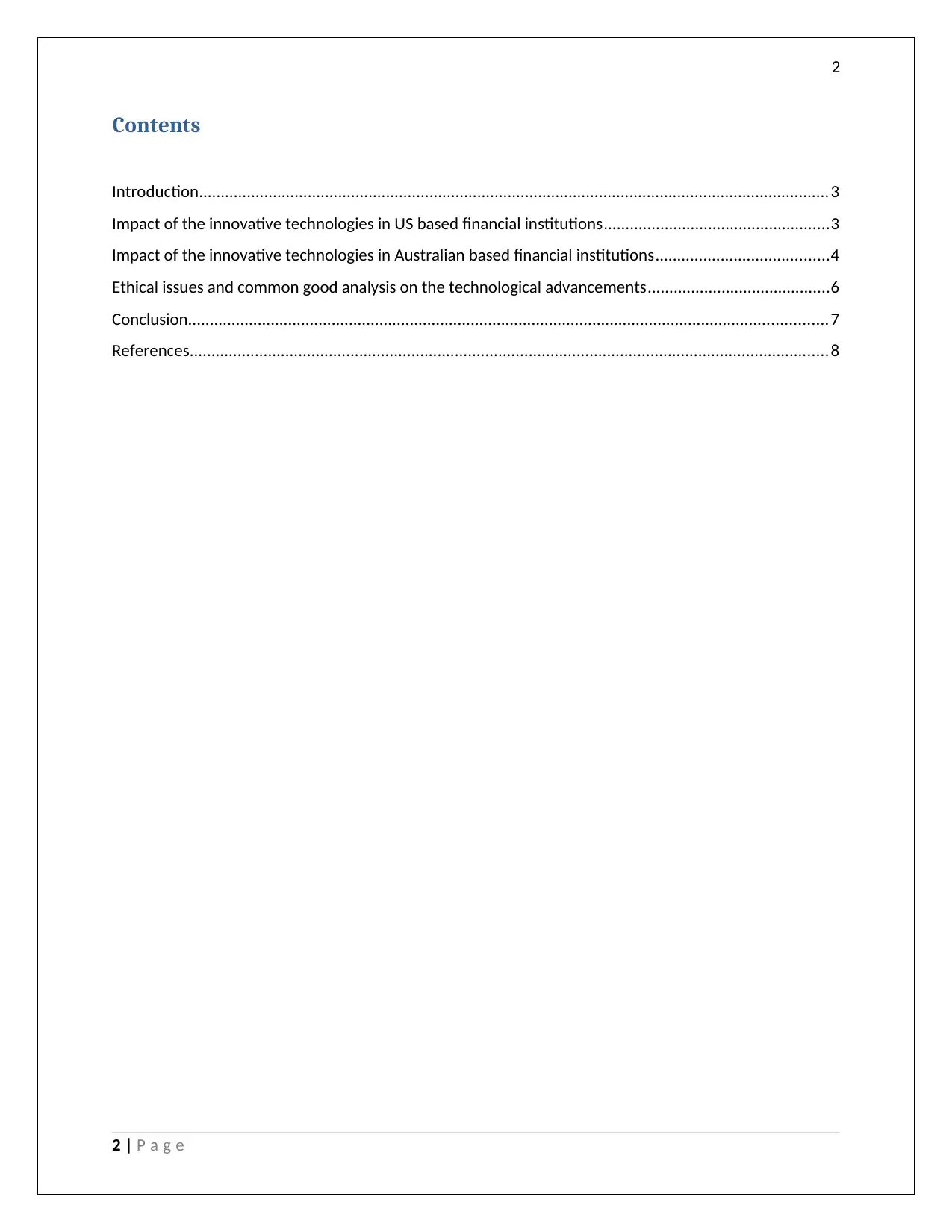
2
Contents
Introduction.................................................................................................................................................3
Impact of the innovative technologies in US based financial institutions....................................................3
Impact of the innovative technologies in Australian based financial institutions........................................4
Ethical issues and common good analysis on the technological advancements..........................................6
Conclusion...................................................................................................................................................7
References...................................................................................................................................................8
2 | P a g e
Contents
Introduction.................................................................................................................................................3
Impact of the innovative technologies in US based financial institutions....................................................3
Impact of the innovative technologies in Australian based financial institutions........................................4
Ethical issues and common good analysis on the technological advancements..........................................6
Conclusion...................................................................................................................................................7
References...................................................................................................................................................8
2 | P a g e
⊘ This is a preview!⊘
Do you want full access?
Subscribe today to unlock all pages.

Trusted by 1+ million students worldwide
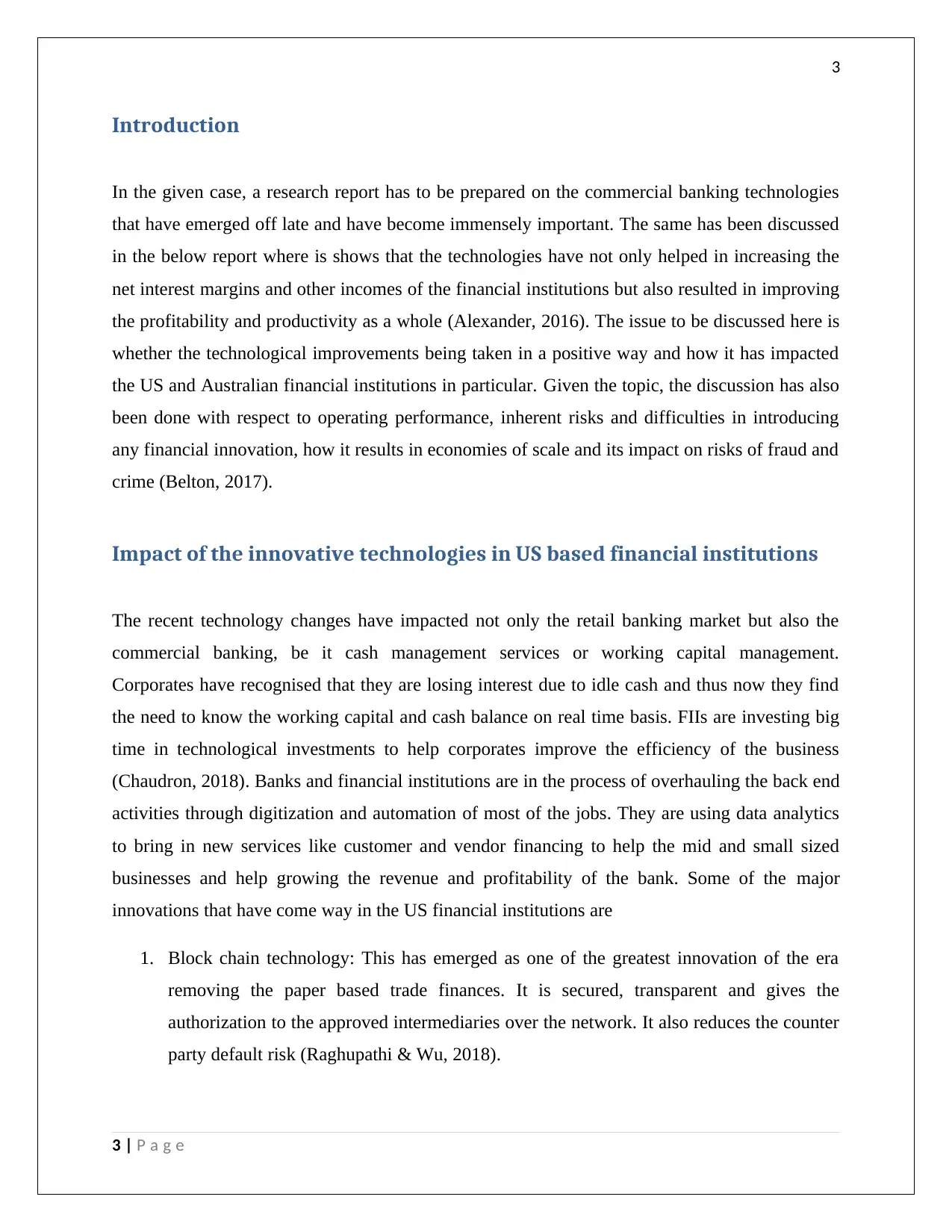
3
Introduction
In the given case, a research report has to be prepared on the commercial banking technologies
that have emerged off late and have become immensely important. The same has been discussed
in the below report where is shows that the technologies have not only helped in increasing the
net interest margins and other incomes of the financial institutions but also resulted in improving
the profitability and productivity as a whole (Alexander, 2016). The issue to be discussed here is
whether the technological improvements being taken in a positive way and how it has impacted
the US and Australian financial institutions in particular. Given the topic, the discussion has also
been done with respect to operating performance, inherent risks and difficulties in introducing
any financial innovation, how it results in economies of scale and its impact on risks of fraud and
crime (Belton, 2017).
Impact of the innovative technologies in US based financial institutions
The recent technology changes have impacted not only the retail banking market but also the
commercial banking, be it cash management services or working capital management.
Corporates have recognised that they are losing interest due to idle cash and thus now they find
the need to know the working capital and cash balance on real time basis. FIIs are investing big
time in technological investments to help corporates improve the efficiency of the business
(Chaudron, 2018). Banks and financial institutions are in the process of overhauling the back end
activities through digitization and automation of most of the jobs. They are using data analytics
to bring in new services like customer and vendor financing to help the mid and small sized
businesses and help growing the revenue and profitability of the bank. Some of the major
innovations that have come way in the US financial institutions are
1. Block chain technology: This has emerged as one of the greatest innovation of the era
removing the paper based trade finances. It is secured, transparent and gives the
authorization to the approved intermediaries over the network. It also reduces the counter
party default risk (Raghupathi & Wu, 2018).
3 | P a g e
Introduction
In the given case, a research report has to be prepared on the commercial banking technologies
that have emerged off late and have become immensely important. The same has been discussed
in the below report where is shows that the technologies have not only helped in increasing the
net interest margins and other incomes of the financial institutions but also resulted in improving
the profitability and productivity as a whole (Alexander, 2016). The issue to be discussed here is
whether the technological improvements being taken in a positive way and how it has impacted
the US and Australian financial institutions in particular. Given the topic, the discussion has also
been done with respect to operating performance, inherent risks and difficulties in introducing
any financial innovation, how it results in economies of scale and its impact on risks of fraud and
crime (Belton, 2017).
Impact of the innovative technologies in US based financial institutions
The recent technology changes have impacted not only the retail banking market but also the
commercial banking, be it cash management services or working capital management.
Corporates have recognised that they are losing interest due to idle cash and thus now they find
the need to know the working capital and cash balance on real time basis. FIIs are investing big
time in technological investments to help corporates improve the efficiency of the business
(Chaudron, 2018). Banks and financial institutions are in the process of overhauling the back end
activities through digitization and automation of most of the jobs. They are using data analytics
to bring in new services like customer and vendor financing to help the mid and small sized
businesses and help growing the revenue and profitability of the bank. Some of the major
innovations that have come way in the US financial institutions are
1. Block chain technology: This has emerged as one of the greatest innovation of the era
removing the paper based trade finances. It is secured, transparent and gives the
authorization to the approved intermediaries over the network. It also reduces the counter
party default risk (Raghupathi & Wu, 2018).
3 | P a g e
Paraphrase This Document
Need a fresh take? Get an instant paraphrase of this document with our AI Paraphraser
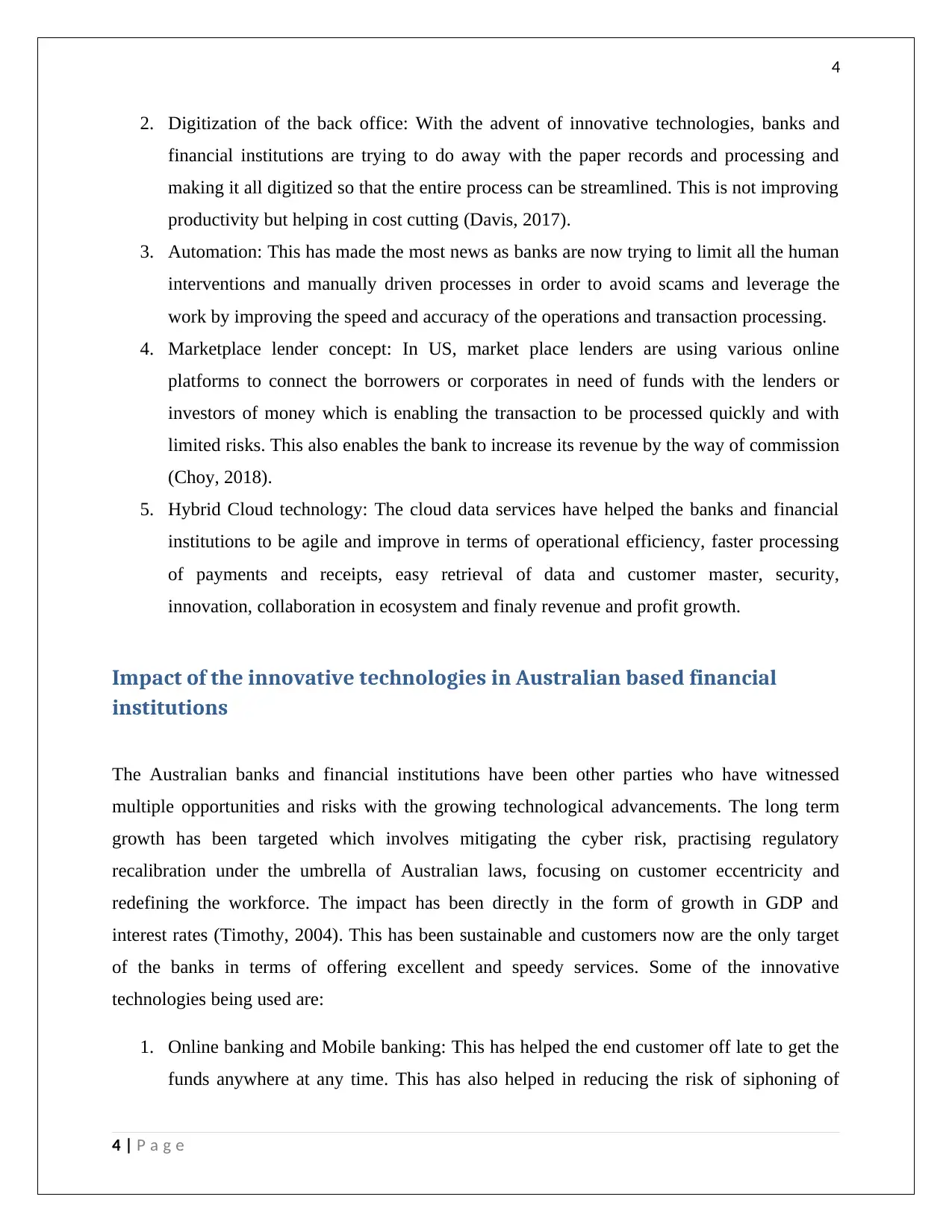
4
2. Digitization of the back office: With the advent of innovative technologies, banks and
financial institutions are trying to do away with the paper records and processing and
making it all digitized so that the entire process can be streamlined. This is not improving
productivity but helping in cost cutting (Davis, 2017).
3. Automation: This has made the most news as banks are now trying to limit all the human
interventions and manually driven processes in order to avoid scams and leverage the
work by improving the speed and accuracy of the operations and transaction processing.
4. Marketplace lender concept: In US, market place lenders are using various online
platforms to connect the borrowers or corporates in need of funds with the lenders or
investors of money which is enabling the transaction to be processed quickly and with
limited risks. This also enables the bank to increase its revenue by the way of commission
(Choy, 2018).
5. Hybrid Cloud technology: The cloud data services have helped the banks and financial
institutions to be agile and improve in terms of operational efficiency, faster processing
of payments and receipts, easy retrieval of data and customer master, security,
innovation, collaboration in ecosystem and finaly revenue and profit growth.
Impact of the innovative technologies in Australian based financial
institutions
The Australian banks and financial institutions have been other parties who have witnessed
multiple opportunities and risks with the growing technological advancements. The long term
growth has been targeted which involves mitigating the cyber risk, practising regulatory
recalibration under the umbrella of Australian laws, focusing on customer eccentricity and
redefining the workforce. The impact has been directly in the form of growth in GDP and
interest rates (Timothy, 2004). This has been sustainable and customers now are the only target
of the banks in terms of offering excellent and speedy services. Some of the innovative
technologies being used are:
1. Online banking and Mobile banking: This has helped the end customer off late to get the
funds anywhere at any time. This has also helped in reducing the risk of siphoning of
4 | P a g e
2. Digitization of the back office: With the advent of innovative technologies, banks and
financial institutions are trying to do away with the paper records and processing and
making it all digitized so that the entire process can be streamlined. This is not improving
productivity but helping in cost cutting (Davis, 2017).
3. Automation: This has made the most news as banks are now trying to limit all the human
interventions and manually driven processes in order to avoid scams and leverage the
work by improving the speed and accuracy of the operations and transaction processing.
4. Marketplace lender concept: In US, market place lenders are using various online
platforms to connect the borrowers or corporates in need of funds with the lenders or
investors of money which is enabling the transaction to be processed quickly and with
limited risks. This also enables the bank to increase its revenue by the way of commission
(Choy, 2018).
5. Hybrid Cloud technology: The cloud data services have helped the banks and financial
institutions to be agile and improve in terms of operational efficiency, faster processing
of payments and receipts, easy retrieval of data and customer master, security,
innovation, collaboration in ecosystem and finaly revenue and profit growth.
Impact of the innovative technologies in Australian based financial
institutions
The Australian banks and financial institutions have been other parties who have witnessed
multiple opportunities and risks with the growing technological advancements. The long term
growth has been targeted which involves mitigating the cyber risk, practising regulatory
recalibration under the umbrella of Australian laws, focusing on customer eccentricity and
redefining the workforce. The impact has been directly in the form of growth in GDP and
interest rates (Timothy, 2004). This has been sustainable and customers now are the only target
of the banks in terms of offering excellent and speedy services. Some of the innovative
technologies being used are:
1. Online banking and Mobile banking: This has helped the end customer off late to get the
funds anywhere at any time. This has also helped in reducing the risk of siphoning of
4 | P a g e
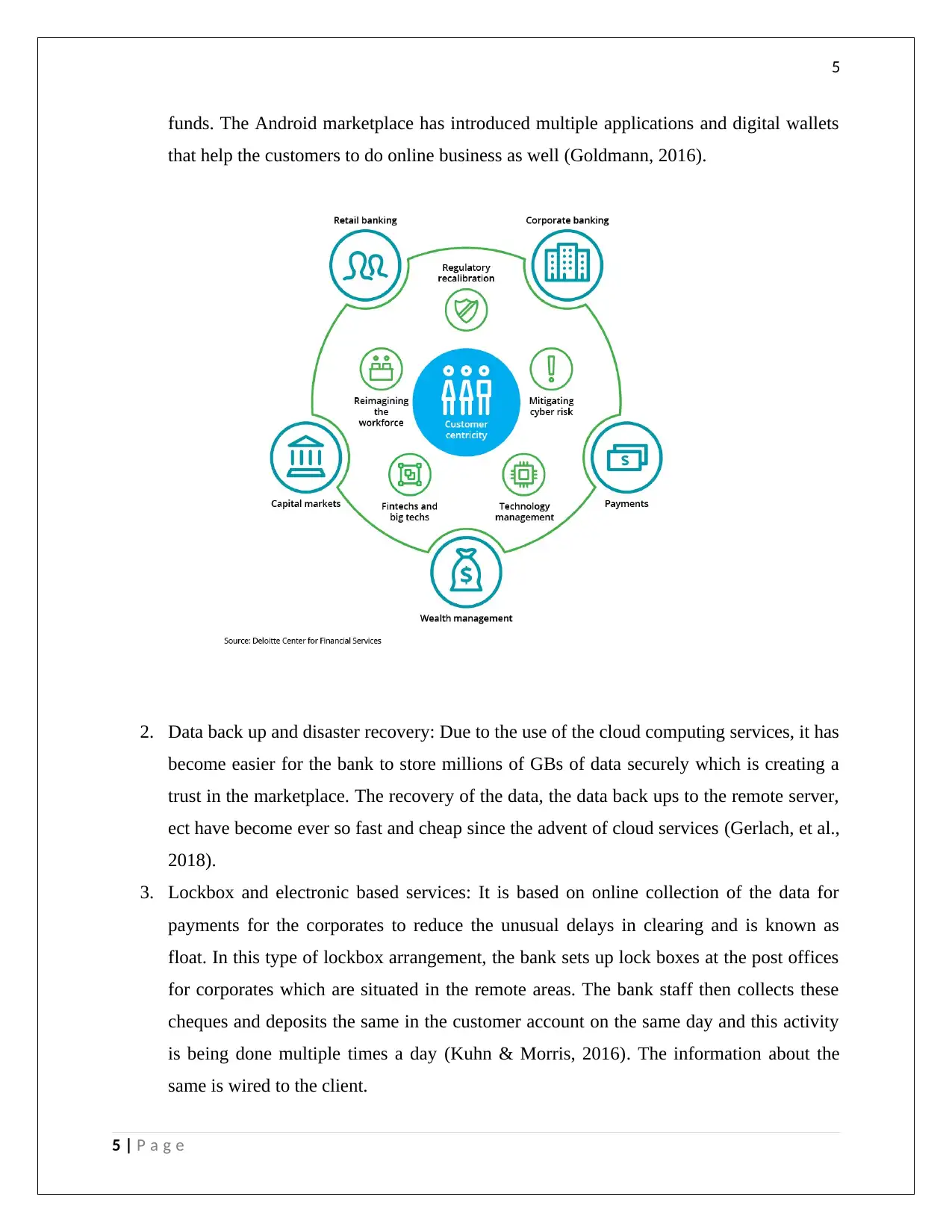
5
funds. The Android marketplace has introduced multiple applications and digital wallets
that help the customers to do online business as well (Goldmann, 2016).
2. Data back up and disaster recovery: Due to the use of the cloud computing services, it has
become easier for the bank to store millions of GBs of data securely which is creating a
trust in the marketplace. The recovery of the data, the data back ups to the remote server,
ect have become ever so fast and cheap since the advent of cloud services (Gerlach, et al.,
2018).
3. Lockbox and electronic based services: It is based on online collection of the data for
payments for the corporates to reduce the unusual delays in clearing and is known as
float. In this type of lockbox arrangement, the bank sets up lock boxes at the post offices
for corporates which are situated in the remote areas. The bank staff then collects these
cheques and deposits the same in the customer account on the same day and this activity
is being done multiple times a day (Kuhn & Morris, 2016). The information about the
same is wired to the client.
5 | P a g e
funds. The Android marketplace has introduced multiple applications and digital wallets
that help the customers to do online business as well (Goldmann, 2016).
2. Data back up and disaster recovery: Due to the use of the cloud computing services, it has
become easier for the bank to store millions of GBs of data securely which is creating a
trust in the marketplace. The recovery of the data, the data back ups to the remote server,
ect have become ever so fast and cheap since the advent of cloud services (Gerlach, et al.,
2018).
3. Lockbox and electronic based services: It is based on online collection of the data for
payments for the corporates to reduce the unusual delays in clearing and is known as
float. In this type of lockbox arrangement, the bank sets up lock boxes at the post offices
for corporates which are situated in the remote areas. The bank staff then collects these
cheques and deposits the same in the customer account on the same day and this activity
is being done multiple times a day (Kuhn & Morris, 2016). The information about the
same is wired to the client.
5 | P a g e
⊘ This is a preview!⊘
Do you want full access?
Subscribe today to unlock all pages.

Trusted by 1+ million students worldwide
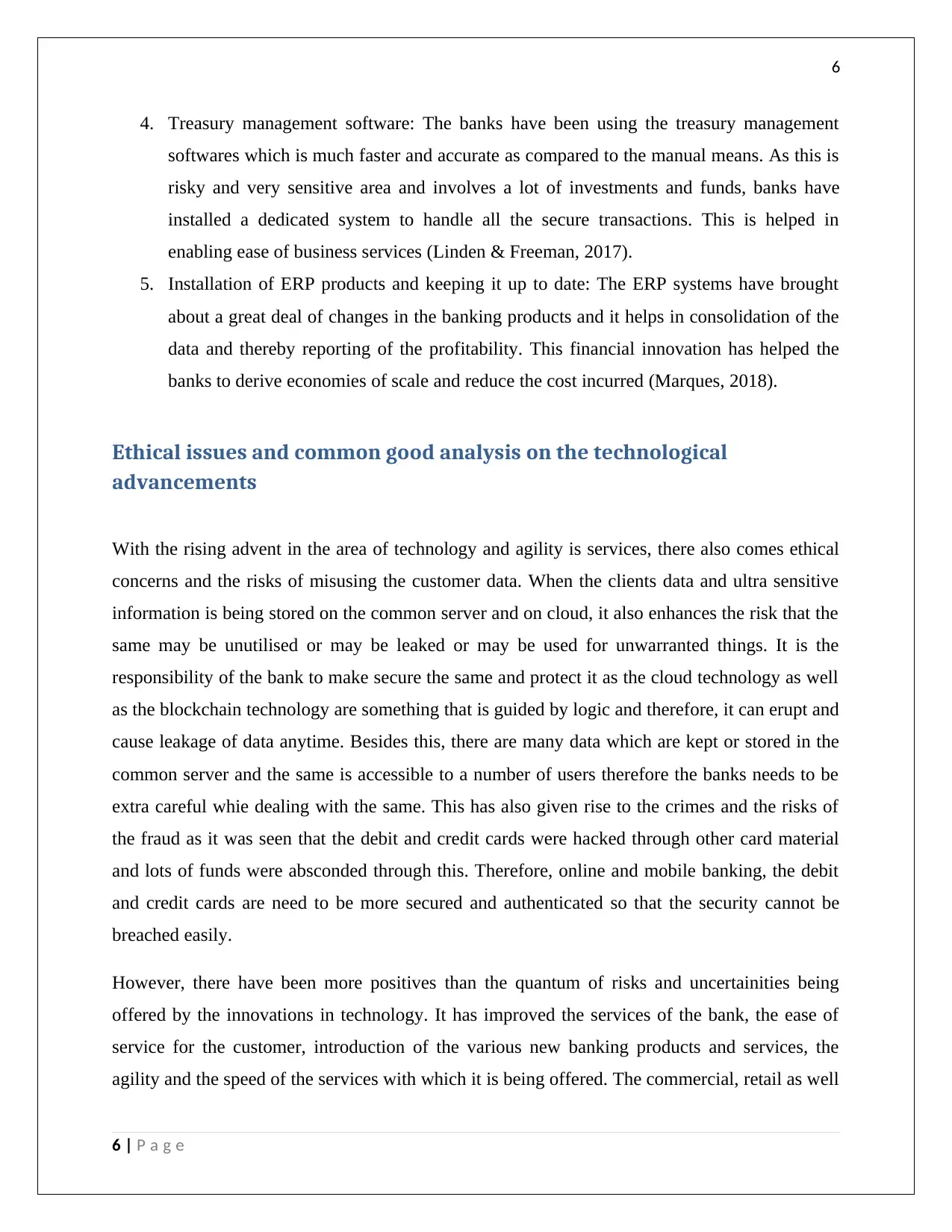
6
4. Treasury management software: The banks have been using the treasury management
softwares which is much faster and accurate as compared to the manual means. As this is
risky and very sensitive area and involves a lot of investments and funds, banks have
installed a dedicated system to handle all the secure transactions. This is helped in
enabling ease of business services (Linden & Freeman, 2017).
5. Installation of ERP products and keeping it up to date: The ERP systems have brought
about a great deal of changes in the banking products and it helps in consolidation of the
data and thereby reporting of the profitability. This financial innovation has helped the
banks to derive economies of scale and reduce the cost incurred (Marques, 2018).
Ethical issues and common good analysis on the technological
advancements
With the rising advent in the area of technology and agility is services, there also comes ethical
concerns and the risks of misusing the customer data. When the clients data and ultra sensitive
information is being stored on the common server and on cloud, it also enhances the risk that the
same may be unutilised or may be leaked or may be used for unwarranted things. It is the
responsibility of the bank to make secure the same and protect it as the cloud technology as well
as the blockchain technology are something that is guided by logic and therefore, it can erupt and
cause leakage of data anytime. Besides this, there are many data which are kept or stored in the
common server and the same is accessible to a number of users therefore the banks needs to be
extra careful whie dealing with the same. This has also given rise to the crimes and the risks of
the fraud as it was seen that the debit and credit cards were hacked through other card material
and lots of funds were absconded through this. Therefore, online and mobile banking, the debit
and credit cards are need to be more secured and authenticated so that the security cannot be
breached easily.
However, there have been more positives than the quantum of risks and uncertainities being
offered by the innovations in technology. It has improved the services of the bank, the ease of
service for the customer, introduction of the various new banking products and services, the
agility and the speed of the services with which it is being offered. The commercial, retail as well
6 | P a g e
4. Treasury management software: The banks have been using the treasury management
softwares which is much faster and accurate as compared to the manual means. As this is
risky and very sensitive area and involves a lot of investments and funds, banks have
installed a dedicated system to handle all the secure transactions. This is helped in
enabling ease of business services (Linden & Freeman, 2017).
5. Installation of ERP products and keeping it up to date: The ERP systems have brought
about a great deal of changes in the banking products and it helps in consolidation of the
data and thereby reporting of the profitability. This financial innovation has helped the
banks to derive economies of scale and reduce the cost incurred (Marques, 2018).
Ethical issues and common good analysis on the technological
advancements
With the rising advent in the area of technology and agility is services, there also comes ethical
concerns and the risks of misusing the customer data. When the clients data and ultra sensitive
information is being stored on the common server and on cloud, it also enhances the risk that the
same may be unutilised or may be leaked or may be used for unwarranted things. It is the
responsibility of the bank to make secure the same and protect it as the cloud technology as well
as the blockchain technology are something that is guided by logic and therefore, it can erupt and
cause leakage of data anytime. Besides this, there are many data which are kept or stored in the
common server and the same is accessible to a number of users therefore the banks needs to be
extra careful whie dealing with the same. This has also given rise to the crimes and the risks of
the fraud as it was seen that the debit and credit cards were hacked through other card material
and lots of funds were absconded through this. Therefore, online and mobile banking, the debit
and credit cards are need to be more secured and authenticated so that the security cannot be
breached easily.
However, there have been more positives than the quantum of risks and uncertainities being
offered by the innovations in technology. It has improved the services of the bank, the ease of
service for the customer, introduction of the various new banking products and services, the
agility and the speed of the services with which it is being offered. The commercial, retail as well
6 | P a g e
Paraphrase This Document
Need a fresh take? Get an instant paraphrase of this document with our AI Paraphraser
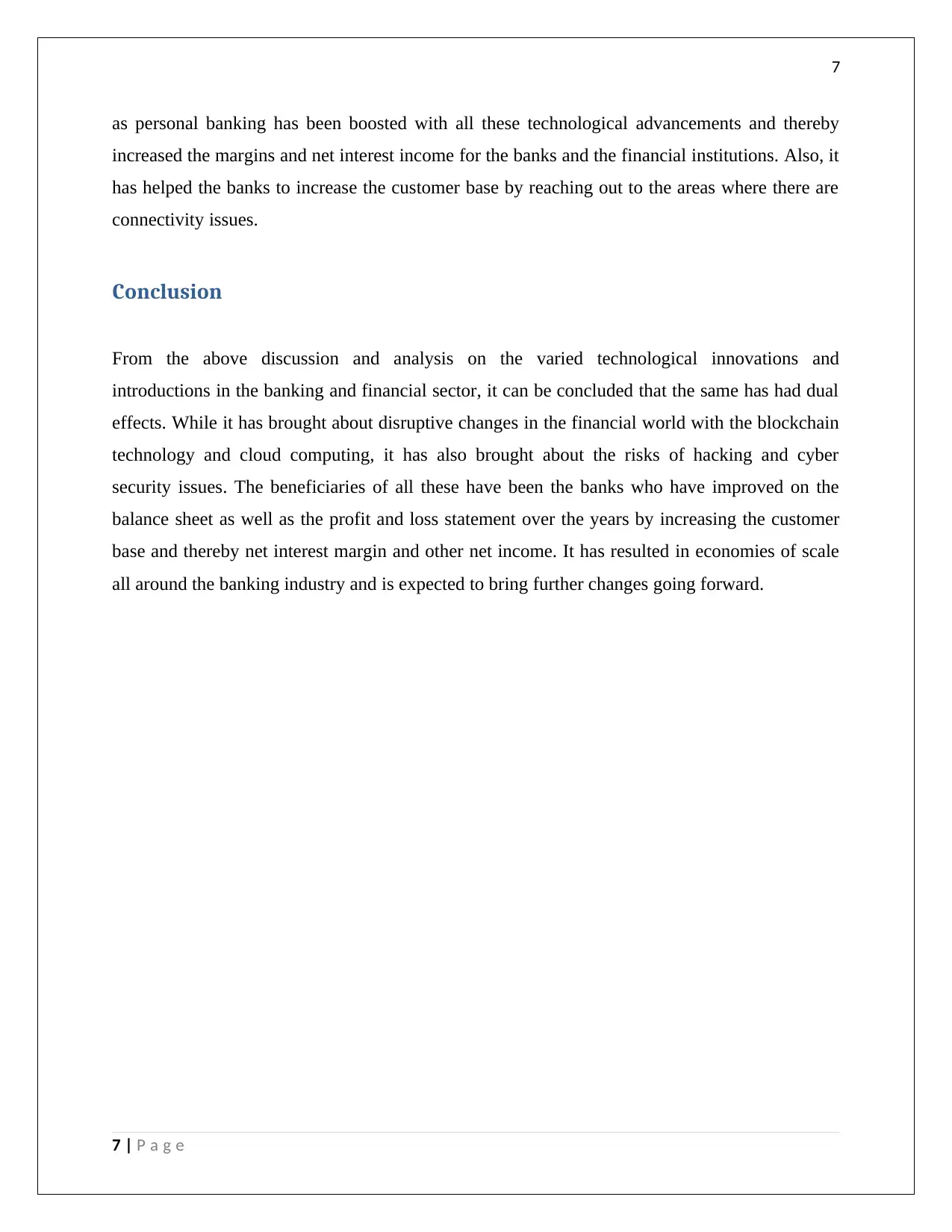
7
as personal banking has been boosted with all these technological advancements and thereby
increased the margins and net interest income for the banks and the financial institutions. Also, it
has helped the banks to increase the customer base by reaching out to the areas where there are
connectivity issues.
Conclusion
From the above discussion and analysis on the varied technological innovations and
introductions in the banking and financial sector, it can be concluded that the same has had dual
effects. While it has brought about disruptive changes in the financial world with the blockchain
technology and cloud computing, it has also brought about the risks of hacking and cyber
security issues. The beneficiaries of all these have been the banks who have improved on the
balance sheet as well as the profit and loss statement over the years by increasing the customer
base and thereby net interest margin and other net income. It has resulted in economies of scale
all around the banking industry and is expected to bring further changes going forward.
7 | P a g e
as personal banking has been boosted with all these technological advancements and thereby
increased the margins and net interest income for the banks and the financial institutions. Also, it
has helped the banks to increase the customer base by reaching out to the areas where there are
connectivity issues.
Conclusion
From the above discussion and analysis on the varied technological innovations and
introductions in the banking and financial sector, it can be concluded that the same has had dual
effects. While it has brought about disruptive changes in the financial world with the blockchain
technology and cloud computing, it has also brought about the risks of hacking and cyber
security issues. The beneficiaries of all these have been the banks who have improved on the
balance sheet as well as the profit and loss statement over the years by increasing the customer
base and thereby net interest margin and other net income. It has resulted in economies of scale
all around the banking industry and is expected to bring further changes going forward.
7 | P a g e
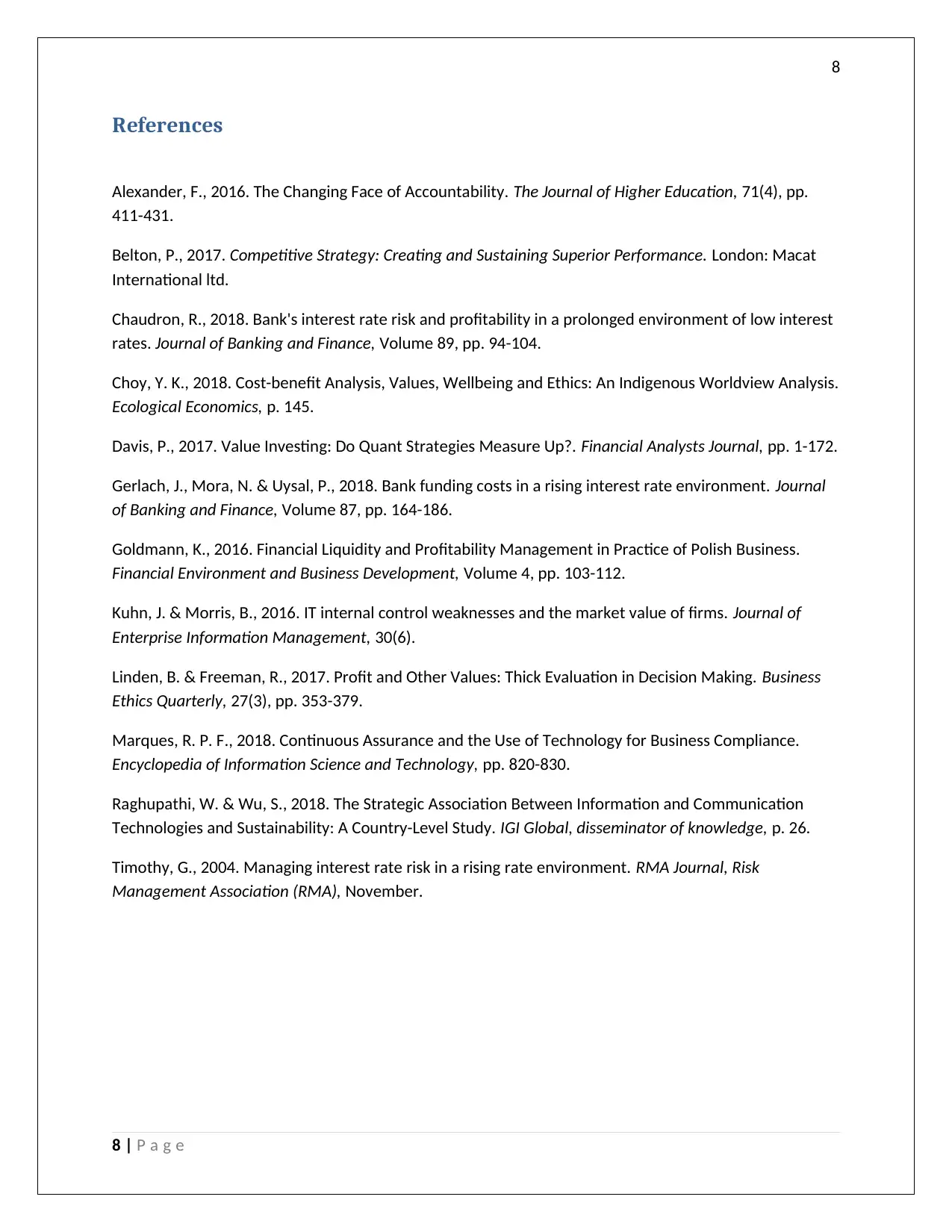
8
References
Alexander, F., 2016. The Changing Face of Accountability. The Journal of Higher Education, 71(4), pp.
411-431.
Belton, P., 2017. Competitive Strategy: Creating and Sustaining Superior Performance. London: Macat
International ltd.
Chaudron, R., 2018. Bank's interest rate risk and profitability in a prolonged environment of low interest
rates. Journal of Banking and Finance, Volume 89, pp. 94-104.
Choy, Y. K., 2018. Cost-benefit Analysis, Values, Wellbeing and Ethics: An Indigenous Worldview Analysis.
Ecological Economics, p. 145.
Davis, P., 2017. Value Investing: Do Quant Strategies Measure Up?. Financial Analysts Journal, pp. 1-172.
Gerlach, J., Mora, N. & Uysal, P., 2018. Bank funding costs in a rising interest rate environment. Journal
of Banking and Finance, Volume 87, pp. 164-186.
Goldmann, K., 2016. Financial Liquidity and Profitability Management in Practice of Polish Business.
Financial Environment and Business Development, Volume 4, pp. 103-112.
Kuhn, J. & Morris, B., 2016. IT internal control weaknesses and the market value of firms. Journal of
Enterprise Information Management, 30(6).
Linden, B. & Freeman, R., 2017. Profit and Other Values: Thick Evaluation in Decision Making. Business
Ethics Quarterly, 27(3), pp. 353-379.
Marques, R. P. F., 2018. Continuous Assurance and the Use of Technology for Business Compliance.
Encyclopedia of Information Science and Technology, pp. 820-830.
Raghupathi, W. & Wu, S., 2018. The Strategic Association Between Information and Communication
Technologies and Sustainability: A Country-Level Study. IGI Global, disseminator of knowledge, p. 26.
Timothy, G., 2004. Managing interest rate risk in a rising rate environment. RMA Journal, Risk
Management Association (RMA), November.
8 | P a g e
References
Alexander, F., 2016. The Changing Face of Accountability. The Journal of Higher Education, 71(4), pp.
411-431.
Belton, P., 2017. Competitive Strategy: Creating and Sustaining Superior Performance. London: Macat
International ltd.
Chaudron, R., 2018. Bank's interest rate risk and profitability in a prolonged environment of low interest
rates. Journal of Banking and Finance, Volume 89, pp. 94-104.
Choy, Y. K., 2018. Cost-benefit Analysis, Values, Wellbeing and Ethics: An Indigenous Worldview Analysis.
Ecological Economics, p. 145.
Davis, P., 2017. Value Investing: Do Quant Strategies Measure Up?. Financial Analysts Journal, pp. 1-172.
Gerlach, J., Mora, N. & Uysal, P., 2018. Bank funding costs in a rising interest rate environment. Journal
of Banking and Finance, Volume 87, pp. 164-186.
Goldmann, K., 2016. Financial Liquidity and Profitability Management in Practice of Polish Business.
Financial Environment and Business Development, Volume 4, pp. 103-112.
Kuhn, J. & Morris, B., 2016. IT internal control weaknesses and the market value of firms. Journal of
Enterprise Information Management, 30(6).
Linden, B. & Freeman, R., 2017. Profit and Other Values: Thick Evaluation in Decision Making. Business
Ethics Quarterly, 27(3), pp. 353-379.
Marques, R. P. F., 2018. Continuous Assurance and the Use of Technology for Business Compliance.
Encyclopedia of Information Science and Technology, pp. 820-830.
Raghupathi, W. & Wu, S., 2018. The Strategic Association Between Information and Communication
Technologies and Sustainability: A Country-Level Study. IGI Global, disseminator of knowledge, p. 26.
Timothy, G., 2004. Managing interest rate risk in a rising rate environment. RMA Journal, Risk
Management Association (RMA), November.
8 | P a g e
⊘ This is a preview!⊘
Do you want full access?
Subscribe today to unlock all pages.

Trusted by 1+ million students worldwide
1 out of 9
Related Documents
Your All-in-One AI-Powered Toolkit for Academic Success.
+13062052269
info@desklib.com
Available 24*7 on WhatsApp / Email
![[object Object]](/_next/static/media/star-bottom.7253800d.svg)
Unlock your academic potential
Copyright © 2020–2025 A2Z Services. All Rights Reserved. Developed and managed by ZUCOL.





